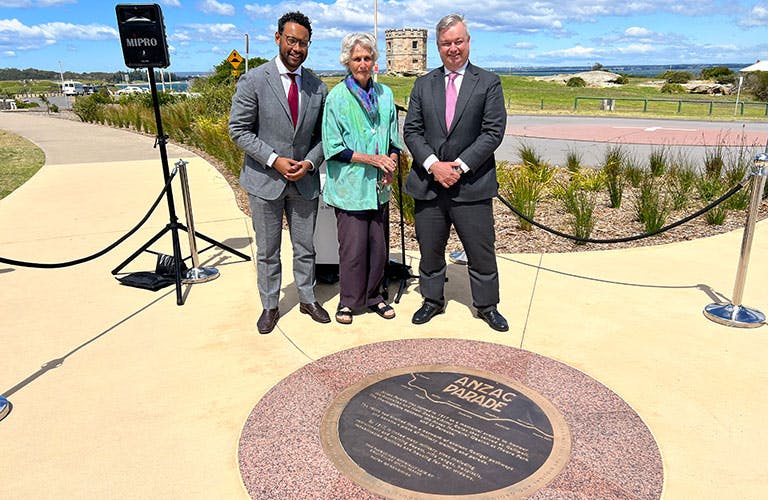Anzac Parade Heritage Study
Consultation has concluded.
Thank you to everyone who shared their stories and experiences. The heritage study's findings and the results of the community consultation were presented at the Ordinary Council Meeting on October 24, 2023. Council resolved to hold a Councillor briefing on the heritage study before the preparation of an Interpretation Plan for Anzac Parade.
Randwick City Council recently commissioned a heritage study which comprehensively explores the pre- and post-colonial history of Anzac Parade.
Spanning from Moore Park in the north to La Perouse at the south, Anzac Parade has long been associated with military/defence activity and is fundamental to the historical development of Randwick City, shaping its character as a municipality.
The study has recognised the Anzac Parade corridor as a unique ‘cultural route’ connecting a number of historic sites with a high degree of heritage significance under the themes of ‘defence’, ‘memorialization’ and ‘governing’. These sites include places formerly used for defence purposes, as well as monuments and reminders in the streetscape of pivotal conflicts of national and international significance.
Click here to read the Anzac Parade Heritage Study.
Click here to read the information sheet (overview of the study)
Why is the Study Important?
The study has found that there is no other road corridor or route in Australia which has the equivalent density of significant sites and surviving relics associated with the themes of defence, memorialisation and governance as Anzac Parade.
The story of Anzac Parade starts with the Dharawal language speakers, particularly the local Cadigal/Gadigal clan, who were the original owners and occupiers of the Randwick Local Government Area (LGA), and whose connection to the area has been maintained to the present day. As a route, Anzac Parade has evolved from natural topography in association with Aboriginal walking tracks and the foundation of the Port Jackson colony in 1788. The military history of the area surrounding Anzac Parade dates back to the first contact, and first conflicts, between the Aboriginal people and the British colonists.
This project has revealed that Anzac Parade is a spine associated with intense military activity from at least 1788 until the second half of the 20th Century, with significant elements still functional today.
After the toll of the 1915 Gallipoli campaign had sunk into public consciousness, the road that roughly bisects the eastern suburbs of Sydney between Moore Park and La Perouse, was named Anzac Parade in 1917, in a memorialisation of the Australian and New Zealand Army Corps (ANZACs) who had paraded along its route.
The story is fundamental to the history of the development of Randwick, its shape and character as a municipality. Recognising, protecting, conserving, and celebrating the living and memorialized heritage of Anzac Parade, including remembering the contribution and service of Indigenous soldiers, is of great value to Randwick City, creating a sense of place and connection to culture.
What is the purpose of the consultation?
The study has made a number of recommendations for conserving and enhancing the heritage value of Anzac Parade as a cultural route, including the preparation of an interpretation plan outlining a number of approaches for expressing the stories and history of the corridor.
The community is invited to contribute to the interpretation plan by:
- Sharing stories, photographs and other historical documentary information that may assist in conveying the significance of Anzac Parade as a cultural route;
- Providing suggestions on how the history, stories and significance of Anzac Parade can be conveyed through interpretation activities and installations.
How can you have your say?
We want your feedback on the study, as well as your stories and your ideas:
Explore the Anzac Parade Cultural Route with our interactive map and drop a pin to add your thoughts. Click here to view the map.
- Position your mouse over the key sites along Anzac Parade to explore historical snapshots from the Study.
- Drop a pin to share your own stories and history of Anzac Parade, as well as share a photo.
- Drop a pin to suggest ideas and locations on how the significance of Anzac Parade can be conveyed through interpretation.
Use the story board to share your memories or family connections to Anzac parade.
Send your stories, photographic and documentary material, as well as suggestions to Council:
- Make an online submission
- Send your comments and documents with the subject 'Anzac Parade Heritage Study' to council@randwick.nsw.gov.au or in writing to the General Manager, Randwick City Council, 30 Frances Street Randwick 2031.
Consultation period: 31 January to 9am 8 March 2023 (extended).
Next steps:
Following the consultation period, the local knowledge gathered will be used to strengthen the existing study, inform the preparation of a new Interpretation Plan for Anzac Parade with targeted options for educating and promoting community awareness about the significance of this cultural route.
Stories
You need to be registered with this site to share a story.
Share your Anzac Parade stories, and recommendations for interpretation below. You can also use the toolbar to add photos, video and links.
You can also send your comments and material using our submission option.




